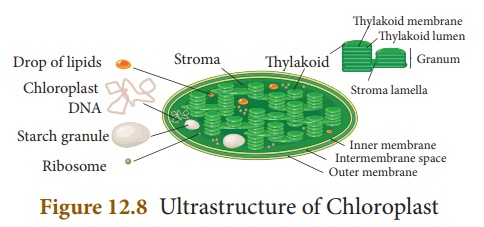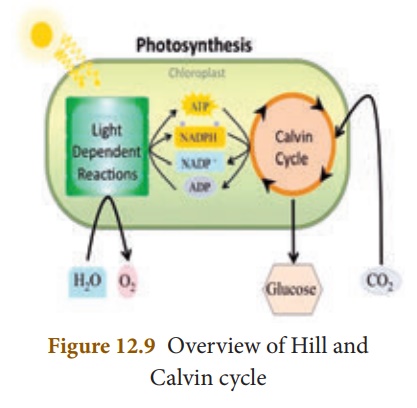Chapter: 10th Science : Chapter 12 : Anatomy and Plant Physiology
Plastids
Plastids
Plastids are double
membrane bound organelles found in plants and some algae. They are responsible
for preparation and storage of food. There are three types of plastids.
Chloroplast - green
coloured plastids
Chromoplast - yellow, red, orange coloured Plastids
Leucoplast - colourless
plastids
1. Structure of Chloroplast
Chloroplasts are green
plastids containing green pigment called chlorophyll. Chloroplasts are
oval shaped organelles having a diameter of 2-10 micrometer and a thickness of
1-2 micrometer.

·
Envelope: Chloroplast envelope has outer and inner membranes which is
seperated by intermembrane space.
·
Stroma: Matrix present inside to the membrane is called stroma. It
contains DNA, 70 S ribosomes and other molecules required for protein
synthesis.
·
Thylakoids: It consists of thylakoid membrane that encloses thylakoid
lumen. Thylakoids forms a stack of disc like structures called a
grana (singular-granum).
·
Grana: Some of the thylakoids are arranged in the form of discs
stacked one above the other. These stacks are termed as grana, they are
interconnected to each other by membranous lamellae called Fret channels.
2. Functions of Chloroplast
1. Photosynthesis 2. Storage of starch 3. Synthesis of fatty acids 4.
Storage of lipids 5. Formation of chloroplasts
3. Photosynthesis
Photosynthesis (Photo
light; synthesis = to build) is a process by which autotrophic organisms like
green plants, algae and chlorophyllcontaining bacteria utilize the energy from
sunlight to synthesize their own food. In this process, carbon dioxide combines
with water in the presence of sunlight and chlorophyll to form carbohydrates.
During this process oxygen is released as a byproduct.

4. Where does photosynthesis occur?
Photosynthesis occurs in
green parts of the plant such as leaves, stems and floral buds.
5. Photosynthetic Pigments
Pigments involved in
photosynthesis are called Photosynthetic pigments. Photosynthetic
pigments are of two classes namely, the primary pigments and accessory
pigments. Chlorophyll a is the primary pigment that traps solar
energy and converts it into electrical and chemical energy. Thus it is
called the reaction centre. Other pigments such as chlorophyll b and
carotenoids are called accessory pigments as they pass on the absorbed
energy to chlorophyll a (Chl.a) molecule. Reaction centres (Chl. a) and the
accessory pigments (harvesting centre) together are called photosystems.
6. Role of Sunlight in Photosynthesis
The entire process of
photosynthesis takes place inside the chloroplast. The structure of chloroplast
is such that the light dependent (Light reaction) and light independent
(Dark reaction) take place at different sites in the organelle![]()
![]()
1. Light dependent photosynthesis (Hill reaction \ Light reaction)
This was discovered by Robin Hill (1939). This reaction takes place in the presence of light energy in thylakoid membranes (grana) of the chloroplasts. Photosynthetic pigments absorb the light energy and convert it into chemical energy ATP and NADPH2. These products of light reaction move out from the thylakoid to the stroma of the chloroplast.
2. Light independent reactions (Biosynthetic phase)
The second steps (dark
reaction or biosynthetic pathway) is carried out in the stroma. During
this reaction CO2 is reduced into carbohydrates with
the help of light generated ATP and NADPH2. This is
also called as Calvin cycle and is carried out in the absence of light.
In Calvin cycle the
inputs are CO2 from the atmosphere and the ATP and NADPH2
produced from light reaction.


7. Factors Affecting Photosynthesis
a) Internal Factors:
Pigments ii) Leaf age
iii) Accumulation of carbohydrates iv) Hormones
b) External Factors:
i) Light ii) Carbon
dioxide iii) Temperature
iv) Water v) Mineral elements
Related Topics